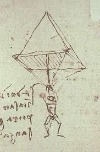Leonardo Da Vinci Inventions
 Many Leonardo da Vinci inventions were futuristic and well advanced for his time.
Many Leonardo da Vinci inventions were futuristic and well advanced for his time.
Many of them did not come into existence for centuries.
Leonardo da Vinci was a autodidact polymath (self taught expert) in architecture, science, engineering, anatomy, geology and botany.
He did not have a formal education in any of these subjects but did study mathematics under the tutelage of the Franciscan friar, Fra Luca Bartolomeo de Paccioli.
Leonardo is most famous for his paintings (Mona Lisa, Last Supper) and in this field of study he received training from the famed Florentine painter Andrea del Verrocchio.
But the da Vinci inventions are astounding because they depict a knowledge and expertise far in advance of what anyone knew at the time. For this reason, da Vinci was considered a genius of scientific principles.
Leonardo da Vinci Parachute Invention
Leonardo da Vinci kept journals of his inventions. In these journals were details and sketches of his inventions.
Here is a list of things Leonardo da Vinci invented: the helicopter, tank, hang glider, convex lens-grinding machine, strut bridge, automated bobbin winder, hydraulic pump, double hull tanker, parachute, finned mortar shell, whirl pool, scuba diving suit, crossbow, machine gun, drilling machine, ignition device, crank mechanisms and various musical instruments.
 Leonardo died in 1519 and his journals were not published for another 165 years. These journals were published as collections such as the twelve-volume Codex Atlanticus which belongs to the Biblioteca Ambrosiana Museum in Milan, Italy.
Leonardo died in 1519 and his journals were not published for another 165 years. These journals were published as collections such as the twelve-volume Codex Atlanticus which belongs to the Biblioteca Ambrosiana Museum in Milan, Italy.
Additional collections are in France (Louvre Museum), in England (Royal Library at Windsor Castle, Victoria and Albert Museum in London, and the British Library), and in Spain (Biblioteca Nacional de España Museum in Madrid).
There is only one collection that is owned privately. The Codex Leicester belongs to Bill Gates.
da Vinci Secrets
 During Da Vinci's lifetime it was common in Europe for inventions to be copied or stolen with no compensation or credit given to an inventor. Often, it was governments that would steal the invention from their citizens.
During Da Vinci's lifetime it was common in Europe for inventions to be copied or stolen with no compensation or credit given to an inventor. Often, it was governments that would steal the invention from their citizens.
An exception to this corruption was the Republic of Venice where da Vinci had lived and worked. It was in this Republic where he created many of his inventions.
The Venetians treated inventors as very important citizens. They were known as "inventio", from which we derive the word "inventor".
There was also a doctrine granting inventors great privileges. This doctrine was known as "patere", from which we derive the word "patent".
The Venetians went to great lengths to protect their ideas, inventions and inventors. The Republic became a haven for inventors and it resulted in a wealthy monopoly over a number of technologies for the Republic and their inventors.
Many of the da Vinci inventions were written in a mirror-image cursive, a technique used by the Venetians to inhibit reading comprehension of text. It could only be deciphered by reading it's reflection in a mirror. Mirrors were an innovation monopolized by the Venetians.
Often, da Vinci would omit a critical detail in his notes such as a gear or lever that was essential to make his invention function. This was another method the Venetians used to protect their inventions. This practice would later become known as keeping a trade secret.
Source: Excerpt from 5 Big Lies - On Selling Invention Ideas, Randy Belaire. This is one of a series of free ebooks you can receive when you claim a free copy of 5 Big Lies - On Selling Invention Ideas.





